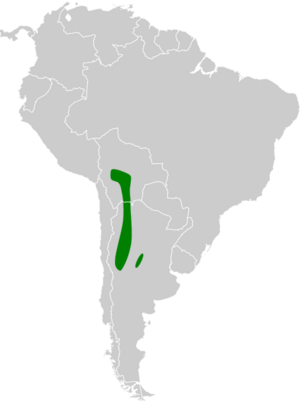Brown-capped tit-spinetail facts for kids
Quick facts for kids Brown-capped tit-spinetail |
|
|---|---|
 |
|
| Conservation status | |
| Scientific classification | |
| Genus: |
Leptasthenura
|
| Species: |
fuliginiceps
|
 |
|
The brown-capped tit-spinetail is a small, active bird. It's part of the ovenbird family, known for building interesting nests. You can find this bird living in the mountains of Argentina and Bolivia. Its scientific name is Leptasthenura fuliginiceps.
Contents
About the Brown-capped Tit-Spinetail
This bird has two main groups, called subspecies. They are a bit different from each other. One group is called L. f. fuliginiceps and the other is L. f. paranensis. Scientists gave them these names to help tell them apart.
What Does This Bird Look Like?
The brown-capped tit-spinetail is about 15 to 16 centimeters (6 inches) long. It weighs between 9 and 13 grams (about half an ounce). It's a slender bird with a long tail and a short beak. Both male and female birds look the same.
Its head has a brown cap and a pale stripe above its eye. Its back is brownish, and its lower back and rump are a reddish-brown color. The wings are mostly reddish-brown too. Its tail is also reddish-brown and looks a bit spiny at the tips. The belly area is a pale brownish color.
Where Do These Birds Live?
The brown-capped tit-spinetail lives in the Andes mountains. The L. f. fuliginiceps group is found in the Bolivian Andes. This includes areas like La Paz, Potosí, and Tarija.
The L. f. paranensis group lives in the Andes of northwestern Argentina. You can find them in provinces like Jujuy, Salta, Mendoza, Córdoba, and San Luis.
These birds live in different kinds of mountain areas. They like dry, semi-wet, or wet scrublands. They also live in woodlands with special trees called Polylepis. In Bolivia, they live at heights between 1,500 and 3,900 meters (about 4,900 to 12,800 feet). In Argentina, they are found between 1,000 and 2,500 meters (about 3,300 to 8,200 feet) high.
How the Brown-capped Tit-Spinetail Behaves
Moving Around
Most brown-capped tit-spinetails stay in the same area all year. However, some birds in Argentina might move to different elevations depending on the season. They might go higher or lower in the mountains.
What Do They Eat?
These birds mostly eat arthropods, which are small creatures like insects and spiders. They usually look for food in pairs or small groups. Sometimes, they join other bird species to forage together.
They search for food from the lower parts of trees all the way up to the top. They often pick their prey off leaves, small branches, or tree bark. Sometimes, they even hang upside down to reach their meal!
Building Nests and Raising Young
The brown-capped tit-spinetail builds its nest during the spring and summer in the southern part of the world. Scientists think they stay with one partner.
Their nest is shaped like a ball and made of plant materials. Inside, it's lined with soft plant fibers, fluffy down, and feathers. They usually build their nests in cracks in rocks or buildings. A female bird typically lays two or three eggs. We don't know much about how long the eggs take to hatch or when the young birds leave the nest.
What Sounds Do They Make?
The full song of the brown-capped tit-spinetail has not been described yet. However, their call sounds like a faint, insect-like "pree."
Conservation Status
The IUCN (International Union for Conservation of Nature) says the brown-capped tit-spinetail is a species of "Least Concern." This means they are not currently in danger of disappearing. They live across a large area, and their population seems to be stable. There are no immediate threats that worry scientists. These birds are considered uncommon in some places but common in others.


